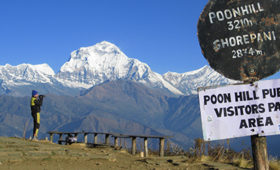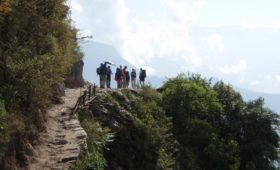The “Trek to Everest Base Camp” is a pilgrimage for adventure seekers, a journey that transcends mere physical exertion and transforms into a profound connection with the world’s highest peak. This iconic trek, etched in the dreams of mountaineers and wanderers alike, offers an unparalleled experience of Himalayan grandeur and cultural immersion. This comprehensive guide will equip you with the knowledge and inspiration to embark on your own unforgettable adventure.
Why the Trek to Everest Base Camp?
- Witness Himalayan Majesty: Stand at the foot of Mount Everest, surrounded by a panorama of towering peaks like Lhotse, Nuptse, and Ama Dablam.
- Immerse Yourself in Sherpa Culture: Experience the unique traditions and warm hospitality of the Sherpa people, the guardians of the Everest region.
- Challenge Yourself: The trek’s challenging terrain and high altitude offer a rewarding physical and mental test.
- Create Lifelong Memories: Forge unforgettable memories amidst breathtaking landscapes and profound cultural encounters.
- Achieve a Dream: For many, reaching Everest Base Camp is a lifelong dream, a testament to human resilience and determination.
Planning Your Trek to Everest Base Camp:
- Choosing the Right Time:
- Spring (March to May): Stable weather, clear skies, and blooming rhododendrons make this a prime trekking season.
- Autumn (September to November): Post-monsoon clarity, mild temperatures, and stable weather offer another excellent window.
- Avoid the monsoon season (June to August) due to heavy rainfall and winter (December to February) due to extreme cold and potential snowfall.
- Physical Preparation:
- The trek requires good physical fitness. Begin training several months in advance, focusing on cardiovascular endurance, strength, and stamina.
- Incorporate hiking, running, cycling, and strength training into your routine.
- Practice hiking with a weighted backpack to simulate trekking conditions.
- Acclimatization:
- Altitude sickness is a serious concern. Plan your trek with gradual ascents and rest days to allow your body to adjust.
- Stay hydrated, avoid alcohol and caffeine, and listen to your body’s signals.
- Packing Essentials:
- Warm Clothing: Layers of thermal underwear, fleece jackets, and a down jacket are essential.
- Waterproof Gear: A waterproof jacket and pants are crucial for unpredictable weather.
- Sturdy Hiking Boots: Invest in high-quality, waterproof hiking boots that are broken in before your trek.
- Sleeping Bag: Bring a sleeping bag suitable for sub-zero temperatures.
- First-Aid Kit: Include altitude sickness medication, pain relievers, bandages, and antiseptic wipes.
- Water Purification: Pack water purification tablets or a filter.
- Headlamp: Essential for navigating in the dark.
- Trekking Poles: Help reduce strain on your knees and provide stability.
- Sun Protection: Sunscreen, sunglasses, and a wide-brimmed hat.
- Permits and Visas:
- Ensure you have a valid Nepal visa.
- Obtain the necessary trekking permits, including the TIMS card and Sagarmatha National Park entry permit.
- Choosing a Trekking Agency:
- Select a reputable agency with experienced guides who are knowledgeable about the region.
- Ensure they prioritize safety and responsible tourism practices.
- Read reviews and compare prices before making a decision.
The Trekking Itinerary (Typical 12-16 Days):
- Day 1-2: Fly to Lukla and trek to Phakding or Monjo.
- Day 3-4: Trek to Namche Bazaar, the gateway to the Khumbu region.
- Day 5-6: Acclimatization days in Namche Bazaar, including short hikes.
- Day 7-8: Trek to Tengboche, home to the iconic Tengboche Monastery.
- Day 9-10: Trek to Dingboche, another crucial acclimatization stop.
- Day 11: Trek to Lobuche.
- Day 12: Trek to Gorak Shep and Everest Base Camp.
- Day 13: Hike to Kala Patthar for panoramic views of Everest and surrounding peaks.
- Day 14-16: Descend to Lukla and fly back to Kathmandu.
Essential Tips for Success:
- Acclimatize Gradually: Don’t rush the ascent.
- Stay Hydrated: Drink plenty of water throughout the day.
- Eat Well: Maintain a balanced diet to provide your body with the necessary energy.
- Listen to Your Body: Rest when needed and don’t push yourself too hard.
- Respect Local Culture: Dress modestly and be mindful of local customs.
- Enjoy the Journey: Savor the breathtaking scenery and cultural experiences.




